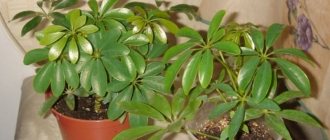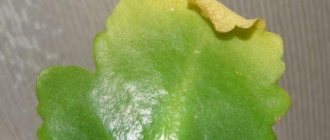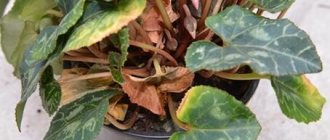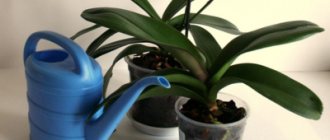Steam bath
Heat the water to 80-90 degrees and pour it into a wide container. Place a stand in it, which should protrude slightly from the water, and place a pot with a dried flower on it. It must be kept until the water cools completely. To bring the plant back to life, at least five such procedures should be carried out.
You can also turn on hot water in the bathroom, close the door and heat the air with steam to 45 degrees. Turn off the water and place a flower pot in the heated bathroom. Leave it until the air cools completely. Do not exceed the specified temperature, this may harm the plant.
Lack of moisture
Another reason for yellowing leaves is insufficient watering. We must not forget about the plant and water it only occasionally. Only cacti prefer dry climates. All others should be watered at least 2-3 times a month.
In overdried soil, the plant does not receive nutrients or moisture, dries from the leaves to the roots and dies.
A feature of overdried plants is the rejection of water. No matter how much you water them, the soil remains “lumpy”, flows out through cracks in the soil directly into the pan and is not absorbed. There is a way to restore such plants:
- Pour water at room temperature into a basin.
- Place a pot with a dried flower in this water so that the water covers it completely.
- Press down on top with something to prevent the pot from floating.
- Add a drop of detergent to the water or lather a little laundry soap to reduce the water-repellent properties of dry soil.
- Wait about an hour.
- Remove the pot from the basin and allow excess water to drain.
- Add fresh soil to the plant.
- Put it back in its original place.
Spraying
Another way to restore a wilted plant is by spraying. It can be done using:
- hydrogen peroxide solution;
- succinic acid solution.
To prepare a hydrogen peroxide solution you will need:
- one liter of boiled or settled water;
- one tablespoon of 3% hydrogen peroxide.
Mix these components, pour into a spray bottle and spray the dried plant every day until it “comes to its senses.” This solution is very good to use for spraying and watering other indoor plants - once a week. Just do not pour this solution into completely dry soil; first moisten it slightly with water so as not to burn the roots.
For a solution of succinic acid you will need:
- one liter of settled water;
- two grams of succinic acid powder or tablets.
Dissolve succinic acid tablets or powder in a small amount of water, mix well, then add the required amount of water to the desired volume. This solution should be sprayed on a dried plant once a day for a week. The procedure can be repeated for other indoor plants at intervals of two to three weeks. Succinic acid stimulates the growth of individual plant parts.
Banana peel as fertilizer for indoor plants.
The easiest way and at the same time very inexpensive is to make your own homemade banana fertilizer for indoor plants. Of course, it is more effective to use the pulp, but banana peels are also suitable for simple cases. We will consider both options for preparing fertilizer.
Preparing homemade fertilizer to revive indoor plants from banana peels.
Step 1: Peel the banana and take its peel.
It is better to cut or tear the peel into small pieces to make it easier to work with them.
Step 2. Pour water over the banana peel and let the solution sit for 24 hours.
The water for the solution must be soft and left to stand for 1-2 days. Fresh tap water cannot be used ; it is also undesirable to use boiled water.
Step 3. Strain the tincture through a strainer.
The solution is ready for use. You can water your dying plant with it, it will rise before your eyes.
Preparation of homemade fertilizer for the resuscitation of indoor plants from banana pulp.
How to prepare banana fertilizer for fertilizing and reviving plants - video.
Step 1. Mash the peeled banana pulp into a puree.
If you wish, you can use a blender, because the finer you get, the better.
Step 2. Fill the resulting banana puree with water.
The water, as in the first case, should be settled and soft. Tap water and boiled water are not allowed.
Step 3. Let the solution sit for 15 minutes.
You should not leave the solution for a long time, especially for a day, as in the previous recipe. 15 minutes is enough for the banana pulp to impart all the necessary beneficial properties to the solution.
Step 4. Strain the tincture through a strainer.
The solution is ready to use!
Drip irrigation
This is another way to restore a dried out plant. It will not allow the plant to be flooded, because an excess of moisture is just as detrimental to a flower as its lack. To organize such a system, you will need ordinary medical droppers and a water container.
Action plan:
- Check the dropper for integrity; there should be blowing on both sides.
- The end of the dropper must be weighted with some kind of weight, but not pinched. Otherwise, it will not lie at the bottom, but will float up.
- Place the container with water on a hill and lower one end of the dropper tube into it.
- Open the regulator on the dropper so that the required water flow occurs.
- Attach the second end of the dropper to the stem of the flower.
This method can be used for constant watering of your indoor plants, and also if you have to leave somewhere for a long time.
How to revive a plant?
Before starting resuscitation measures, it is necessary to find out why the plant disappears. This can be determined by the appearance of the leaves or by examining the root system.
With dry leaves
Dry leaves appear as a result of the fact that liquid and nutrients do not reach the root system for various reasons. This could be due to dense soil or insufficient watering. To revive the plant, it must be placed in warm water for a while, and then replanted and fertilized.
Important! Sometimes dry leaves may appear due to burns of the root system as a result of improper application of fertilizers to the soil. In this case, the plant must be replanted, having first rid it of the affected areas of the rhizome.
Yellowed
Spathiphyllum leaves may turn yellow for the following reasons:
- lack of nutrients;
- sunburn.
In the first case, the leaves turn unevenly yellow. Microelements necessary for plant growth and development may not reach the root system due to too dense soil, which retains fertilizers in the upper layers of the soil. To solve the problem you need :
- Choose a special soil based on peat, soil for leafy plants, coarse sand and replant the flower. When replanting, it is necessary to carefully free the rhizomes from the old soil, rinsing them with water, and then drying the flower on a napkin for a couple of hours.
- Spray the plant with complex fertilizer containing boron and calcium.
- Provide watering of the flower with water at room temperature with a reduced level of hardness.
Important! Spathiphyllum is transplanted into pre-moistened soil, and its surface is also moistened with water after transplantation.
When sunburn occurs, the leaves not only change color, but also lose their elasticity . To help the flower, you need to cut off the affected leaves, move the flower to a place with diffused light and feed it with fertilizer.
How to revive a blackened plant?
Blackening of the tips of the leaves can occur as a result of increased dryness of the air in the room. Spathiphyllum is a tropical flower that prefers a warm and humid climate, so it needs to be created with similar conditions.
To increase humidity levels, you need to take the following measures:
- Periodically spray the foliage with a spray bottle.
- Install a special device in the room that humidifies the air.
- Fill the container with water and place it near the plant.
If most of the leaf blade has turned black, the plant is suffering due to excessive watering . Therefore, it is urgent to take the necessary measures:
- Trim off blackened leaves.
- Dry a third of the land. You can check dryness using a wooden stick. If the soil does not stick to it, it means it is dry enough.
- Check the drainage hole and the release of excess moisture from the pot.
- Optimize irrigation by reducing the number of irrigations and the one-time volume of liquid.
How to save spathiphyllum if it has withered?
Plant wilting is the most common problem, which can occur for the following reasons:
- insufficient watering;
- heterogeneous soil;
- the process of rotting of the root system.
With insufficient watering, the surface of the earth becomes crusty, and the leaves become deformed and bend down. However, abundant watering is contraindicated for it; the plant must be moistened gradually. To do this, water it and cover the top of the soil with cellophane. The procedure is repeated every two days.
Advice . If the flower is too dry, you need to remove it from the bowl and completely immerse it in water so that it is saturated with life-giving moisture.
Heterogeneous soil is typical for newly purchased plants, which are transplanted into beautiful bowls to attract attention. However, as a rule, the flower is placed in a new pot along with a lump of earth, which prevents liquid from reaching the roots. In this situation, only replanting into new soil and clearing the rhizomes from solid soil will help.
The most dangerous reason is the development of putrefactive processes in the root system . To save the flower, you will need to replant according to the following algorithm:
- Remove the plant from the bowl.
- Gently shake off the soil from the rhizomes and rinse off the residue with water.
- Dry the roots on paper.
- Remove diseased roots, and sprinkle the cut areas with crushed activated carbon.
- Provide drainage and fill the bowl with soil.
- Moisten the soil.
- Plant spathiphyllum.
- Water.
How to recover if you have turned pale?
Faded leaves can appear for various reasons. Most often this is a violation of watering or lack of fertilizers. But this can also manifest itself as a lack of space in the pot when the root system grows. In this situation, the following measures should be taken :
- Arrange watering of the plant.
- Feed him regularly.
- Transplant the flower into a container of suitable size.
Important! In rare cases, pale leaves may indicate damage to some disease or insect pests, which can be controlled with the help of specialized drugs.
Covered in spots
Most often, brown spots appear on the foliage . This can occur due to suboptimal watering, unsuitable soil, hypothermia, sunburn, exposure to pests and diseases. Spots can also appear as a result of iron deficiency.
It is necessary to provide the plant with good care and place it in a well-lit place without drafts. In case of iron deficiency, appropriate fertilizing will help, and in case of pest infestation, insecticides will help.
What to do if you get sick or are attacked by pests?
Most often, spathiphyllum is subject to the following ailments:
- Gommoz . A sign of the disease is blackened edges of leaves against a background of wilting. Help: removing diseased leaves, treating the foliage with laundry soap, rinsing with water at room temperature.
- Chlorosis . It manifests itself through yellowing of the foliage and its wilting. Occurs due to a lack of iron or hard water. Measures: watering with soft water at room temperature, fertilizing with iron-containing preparations.
- Gray mold . Because of it, a brownish-gray coating appears on the flower. To get rid of it, you should cut off diseased leaves and disinfect the cut areas with activated carbon.
Attention! With infectious rot, only eliminating diseased roots and replanting will help.
Of the pests, spathiphyllum can infect:
- aphid;
- thrips;
- ticks.
They get rid of pests by eliminating the affected areas, treating them with special means and replanting them in new soil.
Replanting in fresh soil
Sometimes a plant dries out not only from lack of moisture, but also for other reasons, for example, due to improper soil composition or an invasion of harmful insects. In this case, you can try replanting the plant in new soil. But you must remember that this must be done carefully, since any transplant can be traumatic for the root system.
How to make a transplant:
- Remove the plant from the pot.
- Carefully free the roots from the old soil.
- Assess the condition and vitality of the root system to the best of your ability.
- Place the plant in new soil.
- Pour in settled water.
When replanting, use a larger pot to provide enough free space for the root system.
Try not to let your houseplants fall into disrepair. It is better to take care of their care in advance than to look for methods of resuscitation later. Don’t forget about feeding, because plants, like people, need healthy food.
Transplanting a plant
When a plant grows for a long time in the same pot and soil, sooner or later it loses its vitality and this is reflected in the yellowing of the leaves and their subsequent shedding.
If you see that there is no longer enough space in the pot, the green “friend” does not fit well, hardly blooms and has begun to wither - it’s time to transplant it into a larger container. And yellowed leaves only increase the need for this task.
The plant also needs replanting because the pot is too large. The roots do not occupy enough space, and in places where there are no roots, the water stagnates and turns into a swamp. This provokes the occurrence of rot and mold. And as a result, the plant sheds its leaves.
Everyone has their own drinking regime
Each flower is unique, and it consumes water according to its own separate pattern. What is acceptable for a rose or tulip will be destructive for an aster or gladiolus. So what to do? Everyone knows that we store the most common types of flowers in water. But if you are given a bouquet whose stems are hollow, then you should literally pour water into them. When the plant does not “drink” well from the vase and you see that it is drying out, add an activated carbon tablet to the vase. And remember, there are flowers that need to be placed in a vase without water. First of all, it is mimosa. It will simply rot in water.
Why French children behave well: eight ways to raise them
"Dad is offended." Agata Muceniece about her relationship with Priluchny after the divorce
The money tree pleases with lush flowering: my secret is in caring for the leaves
To cold lands
Flowers love the cold as much as they love water. Therefore, the cooler the room where they are located, the longer the bouquet will last. If you need to preserve flowers in their original form before an important event, then simply hide them in the refrigerator, after wrapping the stems with a wet rag. You can also leave the bouquet in a room where the air conditioning is active.
The right combination
Flowers are like animals: some are friends with each other, while others hate each other. Of course, this is all figuratively speaking, however, among the flowers there are those that are able to prolong the life of their relatives and those that literally suck it out. Roses and daffodils are the most important “flower bloodsuckers”. These flowers are selfish and next to them all the others will wither. But as for thuja, pelargonium and asterula, such plants prolong the life of all other representatives of the flora.
“We are still friends”: Derevianko commented on the breakup with his wife
Lost weight: what Sofia Tarasova sacrificed for the sake of “VIA Gra” (new photos)
It’s good to wash often: myths about shampoo and hair care that only harm
Stem processing
Water is the main source of beauty in cut flowers. To saturate them with moisture to the maximum, you need to do the following manipulations:
- Rose or lilac - crush the bottom of the stem with a hammer and place in water.
- Gerberas - the stem is pre-treated with salt, then placed in water.
- Chrysanthemum - divide the bottom of the stem in half and insert a match into it.
- Strip the stem at the bottom like a pencil if you were given tulips or daffodils.
Using one or several techniques from our list, you will significantly extend the life of your bouquets, and they will delight you and decorate the room for a very long time.
Found a violation? Report content
When is it needed?
Rescue is required only in situations where the plant has not yet died completely, since otherwise all measures will be useless.
The florist must carefully examine the azalea: the presence of living buds and sprouts is the basis for prompt resuscitation. Also, rescue will be successful if the plant stem remains green. If the stem is damaged, it remains possible for the flower to revive from the rhizome.
This procedure is necessary if the leaves have massively turned yellow, withered or fallen off. First aid is required if the plant is unhealthy or if its parts are mechanically damaged. Also, resuscitation is needed if signs of rotting are clearly visible.
Treatment should also be provided in case of severe pest infestation. The need for resuscitation is determined by the appearance and severity of dangerous symptoms on the flower.
Read about why azalea leaves change color and shape, and what can be done about it, and from this article you will learn about the causes of blackening of foliage and the solution to this problem.
Azalea why leaves fall
When growing an azalea, you may encounter that growth stops, buds are in no hurry to appear, but the main problem is the falling of leaves. Let's try to figure out why azalea sheds its leaves.
The reasons may be the following:
- improper care;
- stress;
- soil is too wet;
- transplantation during flowering;
- parasites.
Women's linen trousers: models and photos of the best looks
So, the first reason is improper care, which contributed to the drying out of the leaves. To save the situation, you need to cut off the leaves that have dried out and create favorable conditions for the plant to grow. The plant loves coolness, clean water, and sufficient sunlight. When the heating is turned on in the house, it is better to place the azalea away from the radiators. If the air in the room is too dry and the temperature is high, the azalea's leaves begin to fade ahead of time. Leaves turn yellow and fall off if the room humidity is low. To solve the problem, you need to place the flower on a tray with wet peat.











